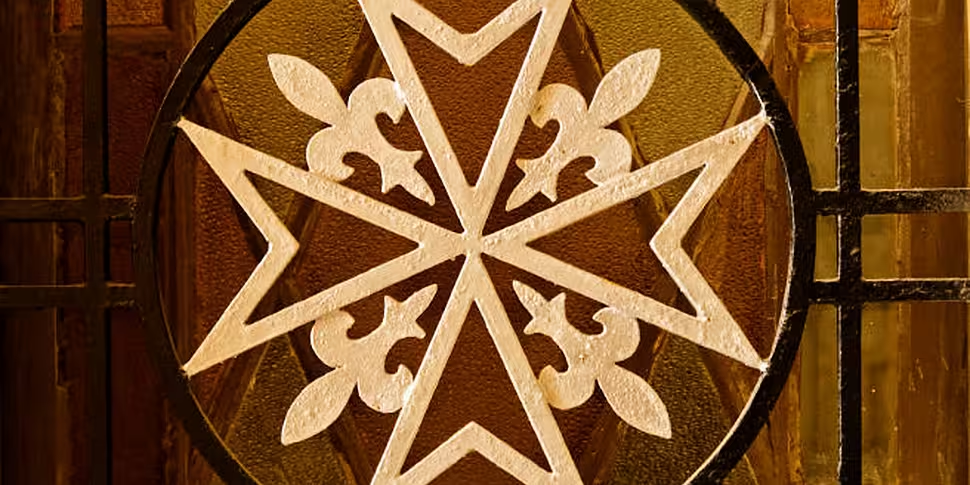Though the Sovereign Military Order of Malta is mainly known for its role in providing medical relief and training there is far more to this organisation than the Order of Malta Ambulance Corps. Recognised as a sovereign subject of international law this nation without a land has embassies spread around the world. The Order issues its own passports, stamps, license plates, and coin and has even been awarded special observer status by the UN. How has this knightly order stood the test of time? Why is their mission still important today?
The Order of Malta stands as the oldest surviving chivalric order. Tracing its roots to early 10th century Jerusalem the order began as a hospital dedicated to St John the Baptist. Staffed by Benedictine monks this hospital provided shelter and care for poor and sick pilgrims. The dynamic changed in 1095, however, when Pope Urban II launched the First Crusade.
Part of a wider conflict between Christian and Islamic powers the Crusade set out to ease military pressure on the Byzantine Empire and claim Jerusalem and the Holy Lands for Christendom. This campaign was a great military success for the Christians and by 1099 the Crusader host had Jerusalem besieged. The Holy City soon fell and the Kingdom of Jerusalem was established.
Throughout the conflict the hospital of St John remained active. As the Crusaders bore down on Jerusalem’s walls and siege became inevitable the city’s Christian population were expelled. The head of the hospital, Friar Gérard Thom, and some monks were allowed to remain and tend those left in their care. From their hospital Gérard and his comrades suffered through the siege and survived the Crusaders’ rampage through the city.
The change of ownership didn’t reduce sickness or lessen suffering in Jerusalem and the hospital of St John continued to care for the needy as before. It was, however, now a Christian mission in a Christian held land. While this brought a massive rise in donations the greatest change was Gérard’s establishment of the Knights Hospitallers in 1099. This body would go on to become one of the most powerful orders during the Crusades, challenging even the Knights Templar in power and prestige.
 'Hospitalier Master Mathieu de Clermont defending the walls of Acre in 1291 in a painting by Dominique Papety, circa 1840
'Hospitalier Master Mathieu de Clermont defending the walls of Acre in 1291 in a painting by Dominique Papety, circa 1840
This martial transformation would take some time to come about and, paradoxically, sprouted from the Hospitallers’ mission to tend to the sick and needy. In 1113 Pope Paschal II recognised the Order of St John and granted them independence from other religious and secular authorities. These political gains were further reinforced in 1185 when the Holy Roman Emperor granted the Order a charter of privileges, which included a pledge of protection from the emperor himself.
This politically favourable wind saw a growth in the Order’s numbers and duties. The original hospital was added onto and the knights began to provide escorts for pilgrims ranging through the Holy Lands. This move from simple carers to active protectors was the start of the Order’s evolution into a military body. Defence of the faith was soon added to their mission of care and by the 13th century the knights were divided into three classes: infirmarian, military, and chaplain.
The battle for the Holy Land established the Order of St John as a military force to be reckoned with; this popularity also saw the Order establish centres across Europe including in Kilmainham. In 1291, however, the Kingdom of Jerusalem fell and the last knights and lords of Christendom were expelled from the Holy Lands. The Order of St John of Jerusalem, left without a home, turned their sights on the island of Rhodes.
 'Last Crusader' by Karl Friedrich Lessing, 19th century
'Last Crusader' by Karl Friedrich Lessing, 19th century
Launching their campaign from the Kingdom of Cyprus the Knights Hospitallers were able to secure Rhodes and some outlying islands as their base of operations by 1309. Though it put an end to their entanglement in Cypriot politics, the move to Rhodes brought new challenges for the Order. As an island nation the knights were forced to change from a terrestrial military power to a primarily naval one.
The Order fought numerous campaigns and battles throughout their time on Rhodes, establishing themselves as a threat against Mediterranean piracy as well as Islamic nations. In 1453, however, Constantinople fell to Sultan Mehmed II and the Byzantine Empire was subsumed into the Ottoman realm. This massive geopolitical change left Rhodes and its garrison as a large thorn in Ottoman Turkey’s side.
In the wake of his victory over the Eastern Roman Empire Mehmed turned his focus on the Knights of St John, launching an attack on the island in 1480. Despite vastly outnumbering the defenders the Ottoman forces were soundly beaten back. Though Mehmed was infuriated by this defeat his death the following year gave Rhodes some breathing space. The knights used this time to massively reinforce their island stronghold and in 1522 these upgrades were put to the test.
With Rhodes continuing to be an obstacle to Ottoman expansion after Mehmed’s failed invasion Sultan Suleiman determined to finally drive the knights from the island. Anticipating the coming invasion the Grand Master of the Order, Philippe Villiers de L’Isle-Adam, called on Europe to send aid. Few responded, amongst them the Prior of the Irish House John Rawson, so when Suleiman’s force of over 100,000 men landed only 7,500 men opposed them.
For six months the Turks laid siege to the fortress. Cannons and mines were brought to bear on the walls and countless assaults were launched against breaches in the fortifications. Yet the Knights of St John held out. Only when all of the walls lay in ruins and the people called for peace did the Order surrender. Though tens of thousands of Turks had died taking the city Suleiman offered the knights and people of Rhodes generous terms. On January 1st 1523 the last of the Order marched from the city to waiting ships in full regalia; though unbroken the Order was homeless once again.
 'The Siege of Rhodes' author unknown, circa 15th Century.
'The Siege of Rhodes' author unknown, circa 15th Century.
The Order roamed through Europe until 1530 when Holy Roman Emperor Charles V granted them dominion over Malta, Gozo, and Tripoli in exchange for one Maltese falcon a year. From this new base the Order relaunched their naval campaigns against the Ottoman Empire and Barbary pirates. This again brought on the ire of Suleiman who dispatched a force to take Malta in 1565.
It was more than hurt pride that drove the Sultan’s action though. In the conflict between Islam and Christendom the European powers had been on the back foot for some time. The seemingly invincible Ottomans were, however, hemmed into the Eastern Mediterranean. In Malta lay a potential key to the West. From here the Ottomans could launch attacks on Sicily and Europe beyond.
On May 18th Suleiman’s armada arrived in Malta and within days his force of around 30-40,000 men had been disembarked. Against this force fewer than 8,000 men were arrayed; the Order and their allies would once again have to weather a siege against vastly superior numbers. Unlike Rhodes, however, Malta was close to the heart of Europe and strategically important for the continent. As a result the garrison could expect support and reinforcement, a luxury not available forty years before.
The Great Siege of Malta was a bloody and vicious affair with atrocities committed by both sides. Numerous times the Order stood on the precipice of destruction, only to be hauled back by fortuitous events or poor Ottoman command. For almost four months the Knights and Turks vied for control of the island. While the Ottoman forces had the weight of numbers the Order had the defensive advantage.
By September the invading force had been worn thin by this attrition campaign. Casualties, of both battlefield and disease, had mounted and morale was crumbling in front of the still standing walls. On the 7th of September Don Garcia landed on Malta with the, well overdue, relief force of some 8,000 men. This force’s first, and only real action, was a savage charge that smashed the Turks the following day. On September 11th the Ottoman forces beat a full retreat.
 'The Siege of Malta - Flight of the Turks' by Matteo Perez d'Aleccio, circa late 16th century.
'The Siege of Malta - Flight of the Turks' by Matteo Perez d'Aleccio, circa late 16th century.
The Great Siege of Malta proved to be the last great battle involving Crusader Knights and a turning point in the conflict between Islam and Christendom. As the modern era progressed and Europe became defined more and more by nation states the Order’s importance and military role waned. When Napoleon landed his forces on Malta in June 1798 there was no prolonged siege or valiant stand against superior forces. The French quickly defeated the forces in western Malta and the rest of the island capitulated soon after.
Though the Order continued to exist after their ousting from Malta the organisation continued to decline until the 19th century. In 1834, after wandering Europe once again, the Order settled in Rome; from here they returned to their original focus as a hospitaller order. Since then the Sovereign Military Order of Malta has enjoyed a resurgence, becoming one of the most important medical missions in the world.
Order of Malta Ireland is part of an International organisation working in over 120 countries, with a heritage stretching all the way back to the Knights Hospitaller who were brought to Ireland in 1174, and whose mission was is to 'serve the sick and the poor'. The Irish Association or ‘Order of Malta Ireland’ was founded in 1934 and four years later in Galway, the Order of Malta Ireland Ambulance Corps was established.
The mission of Order of Malta Ireland is to make a positive contribution to our communities by training and mobilising a network of dedicated volunteers who care for the vulnerable and disadvantaged; the sick and the poor and all who may benefit from our community care initiatives, first aid and youth services, and specialist professional training programmes.
The 4,000 volunteer members of the Order of Malta Ireland Ambulance Corps make a real difference by providing first aid training, ambulance transport and community care and services for older people and those living with disabilities across the whole island of Ireland in over 80 locations across cities and towns . Through our youth division, Order of Malta Cadets, we also offer a range of opportunities for youth development, training programmes and sporting activities.
Join Patrick as he talks with a panel of experts about the history of this most ancient order. What are the duties of the Knights of Malta today? How does the organisation operate and what are its goals? And what does the future look like for the Order of St John?
Patrick also talked with author Jenny Uglow about her book on life in Britian during the Napoleonic wars, 'In These Times'. A full list of 'Talking History' book recommendations can be found here.









